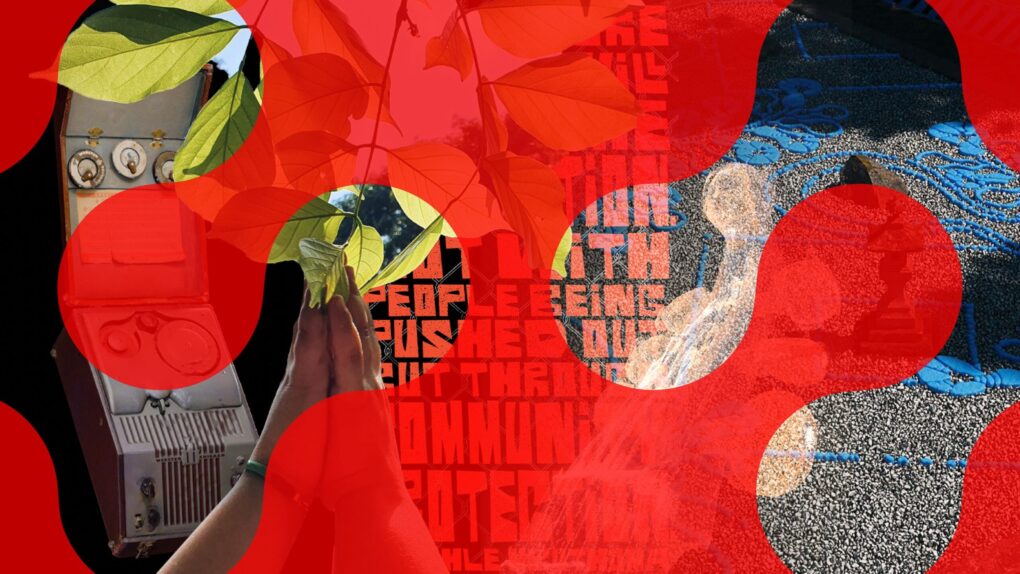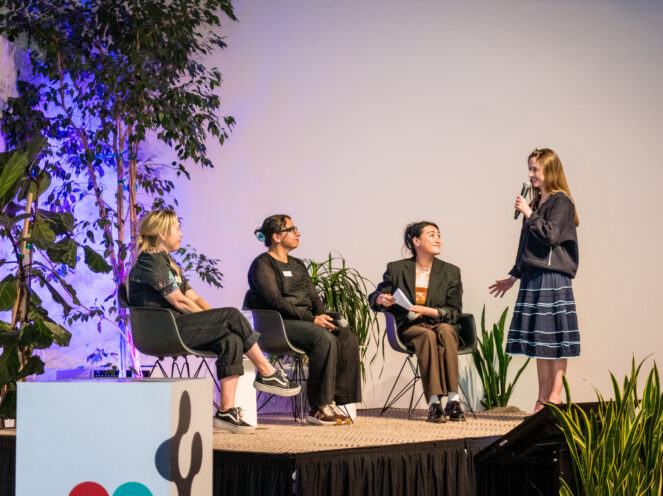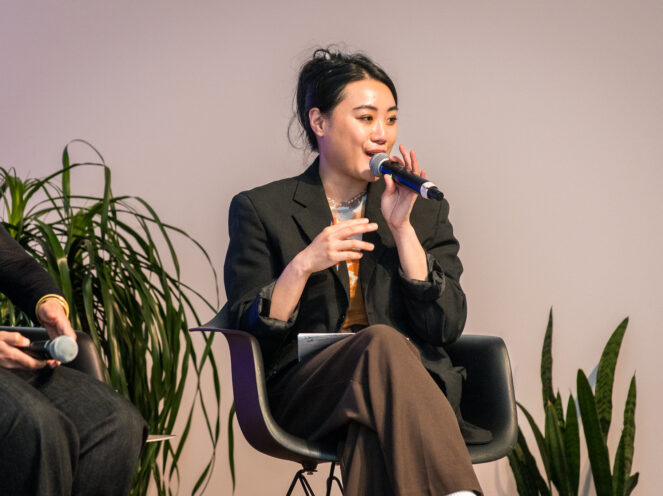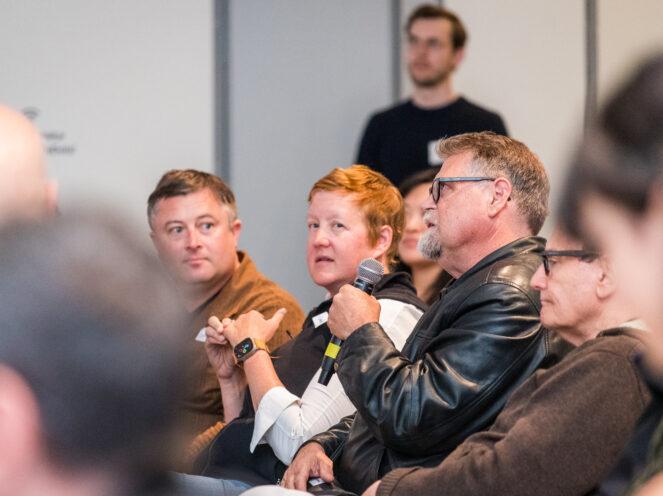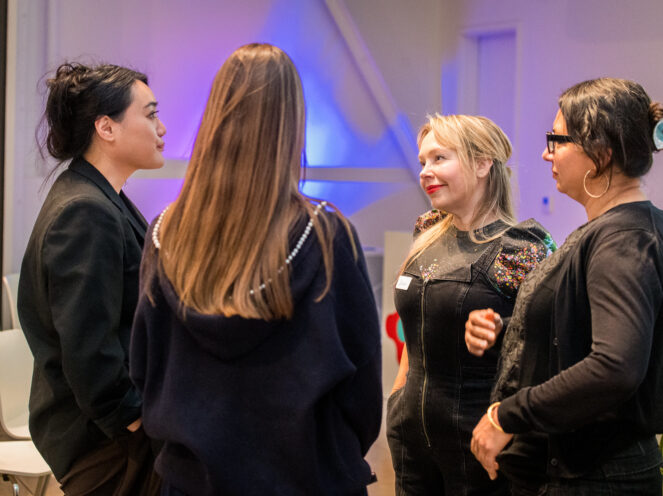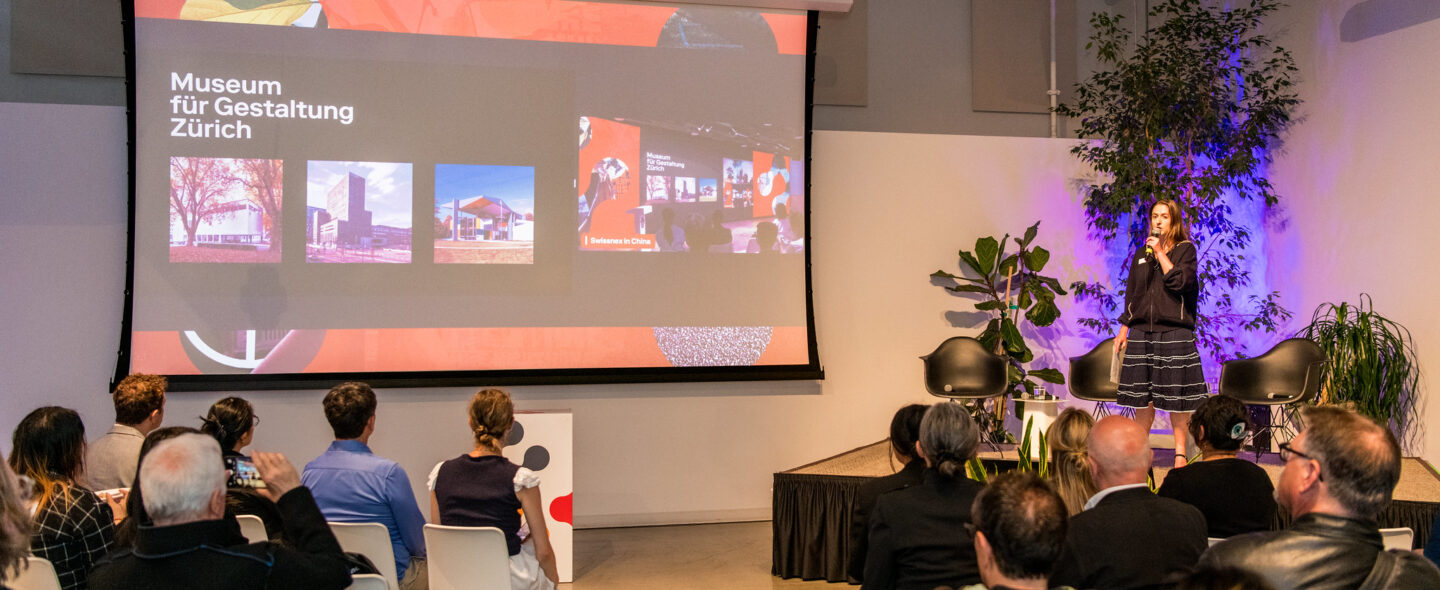
San Francisco – July 3, 2025
Pascale Speck (Global Swissnex Project Lead): The Museum für Gestaltung [The leading Swiss museum for design and visual communication] is celebrating its 150th anniversary this year with a global digital exhibition. What inspired the decision to mark this milestone through international collaboration with the Swissnex Network?
Sophie Grossmann (Global Museum für Gestaltung Curator and Project Initiator): In December of 2022, I visited California and I also came to San Francisco. This was shortly after starting as a research associate at the Museum für Gestaltung for Digital Collecting. It was during a conversation at Swissnex in San Francisco that this idea of a global collaboration with contemporary designers and artists from around the world emerged. When I came back to Zurich, I was very inspired and wondered how I could foster a fruitful exchange between different global perspectives thinking about the knowledge that is held in archives, which are often connected to localized spaces and the potential of virtual spaces as untethered connectors between those different physical hubs. We then decided to invite six different artists to re-imagine and re-contextualize objects from our collection and integrate their perspectives via newly commissioned works.
Pascale Speck: Could you tell us more about the process of selecting the six international artists and designers featured in this project? What kind of curatorial criteria guided your choices?
Sophie Grossmann: One of the things that I focused on was that there is a representation of different design disciplines, but also a certain sensibility for history and cultural heritage. I was looking for artists and designers that within their practice were reflecting contemporary discourses in design and art as well as working with different digital technologies to produce a new aesthetic. Once our choice was made, I invited them to explore the Museum für Gestaltung’s eMuseum and see what sparked their interest. They would send a concept. We would meet regularly over video call and I would listen to them, but also reflect together on what can be made into an exhibit that then can be shown both in a physical space as well as digitally.
Pascale Speck: During the whole development process of the reinterpretations, you worked with all the different chosen artists intensively, and now finally, we’ve actually seen the results. What surprised you the most?
Sophie Grossmann: Indeed, the current moment feels quite nice because it allows the luxury of retrospectively looking at this whole process while planning the presentation of the final works together with the corresponding physical objects from our collection. You can really tell the unique authorship of each piece and also the poetry of it. It was also unlike other commissioned exhibits where there were more specific concepts in regard to the format or content-related aspects. Rather, it’s been a very open process from the conception, to the research and then the final exhibit. But now to see the enthusiasm and different creative visions that were there from the beginning of this project and how they now manifested is such a joy.
Pascale Speck: The whole creation of this project that you came up with is quite striking – it’s very innovative. How do you see the role of curators and curatorship in general change in the digital age?
Sophie Grossmann: A lot of times, collections become visible through projects like exhibitions, publications, etc., but they’re always based on a certain curatorial selection. Enabling new opportunities of sharing different voices and also authorship is a true value of a platform such as the eMuseum. Such a platform can be emancipated from a singular curatorial framework and helps to create a new contextual layer or narrative around these objects, which is a beautiful, and maybe also a crucial addition to the art historical approaches I mostly use when working with archived objects.
-
![]()
Sound Memories – Replay
Watch the recording of "Sound Memories: A Global Dialogue on Preserving Memory Through Sound" - an event co-organized by Swissnex in China and San Francisco on June 6, 2025.
Pascale Speck: A few weeks ago, Swissnex in San Francisco and Swissnex in China organized “Sound Memories”, a hybrid event, together. Why was it important for you to open this dialogue about sound across continents and cultures?
Sophie Grossmann: Because it’s a personal conviction of mine that we can learn from each other and spark each other’s curiosity, especially through a medium such as art. Even though we may be different people with our own subjective experiences within this world, and more specifically also with art, design or even sound, we can connect over a shared interest – in this case these two objects from our collection at the Museum für Gestaltung Zürich. In today’s time, seeing what connects us, what helps us create bridges between each other – also in a global context – is ever so more important.
Pascale Speck: I agree. And besides all the events we created, there’s going to be the big Museum für Gestaltung anniversary exhibition opening at the end of August 2025. All the works from the MfGxSwissnex project are going to be part of this exhibition as well. Could you share with us more of what to expect?
Sophie Grossmann: Sure! All works are going to be shown in an exhibition called “Museum of the Future – 17 Digital Experiments”. The overall show looks at the museum as an institution, where objects and knowledge is collected, researched, presented and interacted with, focusing on the potential but also the limits of digital technologies and AI. The exhibition in itself is a research project that will be evaluated to look at how knowledge transfer or immersion and interactivity within the exhibition space works and why. We present very different approaches and applications, be they artistic or stemming from a research context. With this exhibition we’ve been moving towards the idea of an exhibition as a platform to have the audience experience different exhibits from multiple partners and to directly engage the visitors in the exhibition with participatory formats.
Pascale Speck: That’s very interesting. So I’m hearing it’s really about moving away from single curatorship towards more inviting diverse perspectives. It becomes about creating a platform where different perspectives and projects can be presented and engaged in a broader dialogue with others.
Sophie Grossmann: Absolutely, I think that’s a beautiful description. Also, this is what we’ve achieved with our MfGxSwissnex collaboration: to invite the different perspectives, bring them into an exhibition space, have an openness towards their format in saying also, this is not just a finished work, but there has also been a whole process that has been very much based on a dialogue. That’s something that’s very contemporary and current. I see my role as the curator of this global initiative in encouraging the artists and designers to use their own authorship and, at the same time, to see the link to the knowledge that exists within the museum, around the history of the object or work. For me, the curator’s role in a collaborative setting such as the MfGxSwissnex project is one of a facilitator.
Sound Memories: Event Photos
-
![]()
-
![]()
-
![]()
-
![]()
Pascale Speck: Departing from our experience with this big global collaborative project: What do you take from it that you want to see more of in the future?
Sophie Grossmann: One of my principal project aims was to build bridges between the selected physical objects and digital technology, but also between different design disciplines and different cultural backgrounds. The final works really represent that. Furthermore with our conducted events, you can see that the interconnectedness we fostered is not only on the level of the objects, but really also between the people who have contributed to this project. In German we would say “it has grown its own legs and is starting to walk”, which I think is the best scenario that could have happened out of this project. I hope these dialogues will continue even after the project ends.
Pascale Speck: I hope so too!
Sophie Grossmann: In the end, I would like to encourage everyone to go through the world and through museums “with eyes open like fans”. It’s Charlotte Perriand who coined that phrase and Kumar La Noce’s work for this exhibition who brought it to my attention. It’s really what I love to do. I love seeing things and being receptive to new ideas and perspectives. So, I think in a way what has happened to me is that I’m seeing things differently now through my work with all of you on this project. And it’s wonderful to hear the contributing artists and designers share that sentiment. This has been a real joy.
About the Museum für Gestaltung Zürich
The Museum für Gestaltung Zürich is the leading Swiss museum for design and visual communication. Its collection brings together over half a million objects from the history of graphics and design and is of international importance. As part of the Zurich University of the Arts, ZHdK, the museum is involved in research and teaching and regularly produces its own publications. It offers a variety of digital content to make curated and scientific information accessible and tangible beyond a physical visit. This includes eMuseum.ch. This initiative positions Museum für Gestaltung Zürich as a leader in accessible and forward-thinking cultural curation, charting a bold path for museums in the 21st century.
About the Museum für Gestaltung's Anniversary Project with Swissnex
As museums around the world rethink their role in the digital age, the Museum für Gestaltung Zurich, is teaming up with Swissnex in San Francisco and the Swissnex network around the world to mark its 150th anniversary with a global digital initiative. This initiative reimagines the museum to remain relevant, into one that is digital, forward-looking, and globally connected. By highlighting curated projects and contributing to a cross-cultural dialogue, the global initiative spotlights how tradition and technology can come together to make the collecting of cultural artifacts more accessible and relevant in the 21st century.
